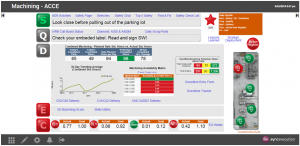Gemba is a term that is increasingly familiar in the manufacturing world. Loosely translated from Japanese, it means “the place where the work is done.” The originators of the Gemba Walk – the practice of walking the shop floor to identify waste – knew that manufacturing process issues could not be identified or solved in the conference room or behind a desk. Management needs to visit where work is done to get a true sense of what actually happens.
Say, for example, you want to reduce changeover time in a particular work center to increase flow velocity. You know what the average changeover time is based on data collected from the shop floor. You can also see that there is a wide variance between minimum and maximum changeovers. What you don’t know is WHY. The only way to get that information is to head out to the shop floor to watch what happens during changeover and talk to the individuals involved.
Information is Power
The purpose of a Gemba Walk is not to confront employees about their performance, but to learn from them, and there are plenty of sources for information on the best way to conduct an effective walk. Unfortunately, many workers have learned to expect criticism every time management shows up on the shop floor. If your organization has a poor history of management/employee relations, you’re probably going to need to put some extra effort into training your managers on the best way to create an environment where employees feel safe about being open and honest about what happens on the floor.
The other trick is to know, ahead of time, something about what is happening as well as what is possible – and that requires data. In the example I gave above, management had collected actual data from the process, so they had a pretty good idea of how long changeovers took and what could conceivably be possible with the right process improvements.
Having system-gathered data is important for two reasons. First, like eye-witnesses to an accident, employees on the front lines may not be the best source of information because their focus was elsewhere. It’s not that they are purposefully deceptive, it’s just tough to recall details of an incident you didn’t anticipate. If you’re tracking something like changeover time manually, your perception of how long the process takes may be wildly off. Even if you write down the start and end time, manual recording processes are prone to error and misrepresentation.
 Having data is also important because it gives you a purpose for your walk. Even though it’s not held in a conference room, a walk with no purpose can feel a lot like attending a meeting with no stated purpose or goal. We’ve all been to one of those. The meeting takes up the allotted time, nothing is decided, and everyone leaves wishing they could get that time back.
Having data is also important because it gives you a purpose for your walk. Even though it’s not held in a conference room, a walk with no purpose can feel a lot like attending a meeting with no stated purpose or goal. We’ve all been to one of those. The meeting takes up the allotted time, nothing is decided, and everyone leaves wishing they could get that time back.
You can ask work center personnel open-ended questions about their daily challenges and ideas for process improvement. If you watch them work, you may even identify areas for improvement that they didn’t see. But having a purpose for the walk – in this case, reducing changeovers – gives the discussion structure and direction and helps workers feel like the time is well spent and makes them more likely to get into the spirit of the Gemba process.
Orbital ATK Uses Synchrono to Power Up Their Gemba Walk
The Synchrono Demand-Driven Manufacturing Platform has a number of tools that increase visibility to the shop floor. At the Industry Week Technology Conference and Expo, the Aerospace Structures Division of Orbital ATK, a manufacturer of composite parts for the aerospace industry, spoke to how they use the dashboards made possible by SyncView to support their Gemba Walk process. You can access that video on YouTube.
Screen used in a Gemba Walk at Orbital ATK
The Gemba Walk segment is about nine minutes into the overall video, but if you have the time, the rest of the presentation by Paul Hardy, Orbital ATK’s Application Architect, is really informative as well – especially for those of you looking to leverage the IIoT in your operations. Also, in the second half of the presentation, John Maher, Vice President of Product Strategy at Synchrono, talks about the metrics manufacturers will be using in the factory of the future.
We’ve also posted an on-demand demo of SyncView on our website so you can take a closer look for yourself. Or reach out to us, and one of our Demand-Driven Manufacturing specialists would be happy to give you a personal tour and answer your questions.




